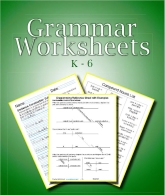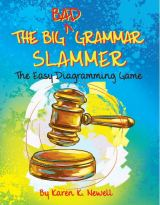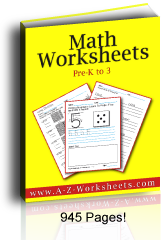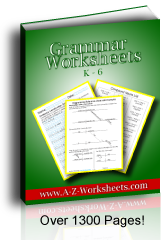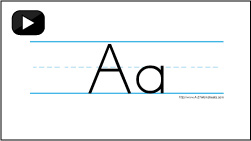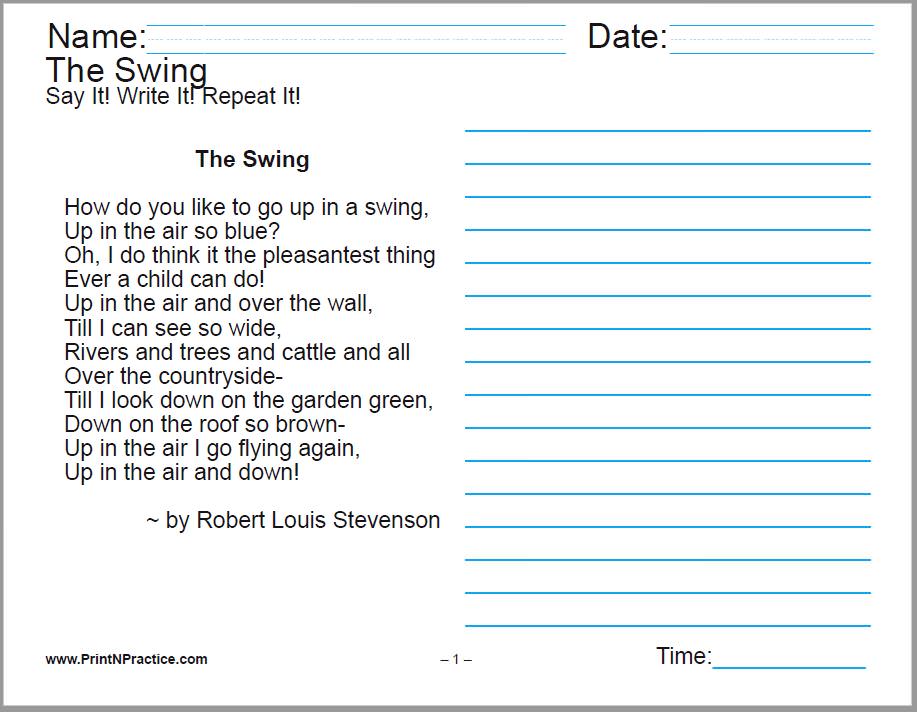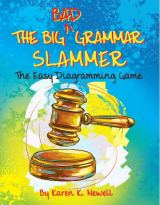English Punctuation Worksheets
Our nine printable punctuation worksheets show easy sentences with commas, question marks, and exclamations for kids to copy. See them below in section 4 on this page.
 Punctuation worksheets give your kids an opportunity to practice the punctuation rules. You print. They practice. See them below.
Punctuation worksheets give your kids an opportunity to practice the punctuation rules. You print. They practice. See them below.The rule or definition is at the top of the worksheet for your children to read and copy with practice examples below.
Use them the day you explain punctuation rules. Then assign the worksheets for practice.
There's also a three page printable punctuation rules chart so you can keep the rules and definitions handy in your own binder.
Be encouraged to stay in touch! Join my free newsletter....
Join To Receive My Free PrintNPractice Newsletters!
Free Online Worksheets For School, Homework, And Homeschool Practice
Free Online Teacher Resources - Free Homeschool Curriculum
For teachers and parents: PrintNPractice free printable worksheets are all copyright-free, digital activities for students. Use them in homeschool, interactive notebooks for online classrooms, Google classroom, distance learning, tutoring and learning pods, and hybrid school.
- No prep.
- No tracking.
- Self learning.
- Copyright free.
- Lifetime license.
- Diverse learners.
- Easy drill-and-kill.
- Interactive worksheets.
- Printable morning work.
- Paperless morning work.
- Go printable or paperless.
- Stay on track. Summer review.
- Easy elementary school curriculum.
- Remote learning packets or homework.
- Most need no answer key or key is included.
- Videos for audio and visual learners. God bless headphones!
See free teacher and homeschool digital interactive school-at-home learning exercises with no login, no tracking, no sign-up, no voucher, no account, and no credit card. Loads of digital activities for device-based learning.
1. Punctuation Dresses Up Sentences
Punctuation makes sentences more interesting or more clear in meaning.
Punctuation divide text into sentences and parts of sentences by means of points and marks:
- comma ( , );
- semicolon ( ; );
- colon ( : );
- period ( . );
- question mark ( ? );
- exclamation mark ( ! );
- dash ( - );
- parentheses ( );
- brackets [ ] or { }....
Emoji punctuation: And of late people use punctuation marks as emojis:
- smiley faces :-),
- winking faces ;-) and
- not so happy faces, :-/
2. Punctuation Marks: Like Sentence Jewelry
Punctuation marks are the marks we use to help others understand what we are saying. They also add emotion to some sentences as with exclamation points.
They dress things up a bit like sentence jewelry accenting our writing.
- Commas let us know that a list is coming or that we want to separate some part of our thoughts from our main thought.
- Semicolons do this in a bigger way.
- A period shows the end of our complete thought.
A bit of punctuation history: We used to put two spaces after a period and a colon, which when being read counted for a full breath.
Question marks and exclamation points were the same.
We still hold a full breath when reading. You can keep the same rule even though the spacing has changed.
Commas and other marks have one space which gets half a breath while reading out loud.
I marvel to see how spacing their breathing this way helps children with their reading comprehension.
See our printable punctuation worksheets below these definitions.
3. List Of Punctuation Marks
3a. Comma Punctuation Rules
Comma definition - A comma is the mark of punctuation ( , ) that denotes the smallest degree of separation between parts of a sentence and frequently indicates that a list or a parenthend follows.
Comma punctuation rules:
- Three or more nouns, pronouns, adjectives, verbs, or adverbs should be separated by commas.
- The members of a compound sentence, when long and connected by conjunctions, should be separated by commas.
- A direct quotation should be set off with a comma.
As you read, leave a short breath's space at a comma to aid diction and reading comprehension.
3b. Semicolon Punctuation Rules
Semicolon definition - A semicolon is the punctuation mark ( ; ) that denotes the next degree of separation between parts of a sentence.
Semicolons are used when
- introducing an example,
- between clauses of compound sentences joined by conjunctions,
- between the clauses of compound sentences when there is no conjunction, or if the clauses are long.
While reading, leave a more full breath's space at a semicolon to aid diction and reading comprehension.
When writing original sentences and when you have already used a comma and you come upon a list that you hadn't planned to use or you add more punctuation than you had expected at the time of writing the comma simply return to that same comma and add the dot. Barbara Beers, The Phonics Road had this excellent idea.
Typing will require a strike and replacement or delete and replace. Strike the comma, and replace with the semicolon.
3c. Colon Punctuation Rules
Colon - A colon is the mark of punctuation ( : ) that denotes a longer degree of separation, equal to that of a period, between parts of a sentence before an example, a list, a lengthy quotation, or after the introduction to a speech.
The colon is also used between numerical combinations as with:
- Bible chapter and verse, Gen. 3:15; or
- volume and page number, The Tribune 23:12.
When reading, leave two breath's space to aid diction and reading comprehension.
3d. Dash Punctuation Rule
Dash - A dash is a straight, horizontal line (-) placed
- where a sentence breaks off suddenly,
- where there is a change in meaning or construction, or
- where marks of parenthesis would be.
3e. Parentheses Punctuation
Parentheses - The marks of parenthesis are the marks of punctuation ( ) that set off unrelated words, phrases, or clauses that do not change the meaning of the sentence when omitted. Use marks of parenthesis in pairs.
3f. Bracket Punctuation
Brackets - Brackets are marks of punctuation, either [ ] or { }, that include words, phrases, or clauses that describe what precedes them or corrects an error.
3g. Period Punctuation Rules
Period - The period is the punctuation mark ( . ) that denotes the end of a declarative or imperative sentence and has the longest degree of separation.
A period is used after every abbreviated word.
When one is reading, leave two breath's space when ending a sentence to aid diction and reading comprehension.
3h. Question Mark Punctuation Rules
Question Mark - The question mark is the punctuation mark (?) that denotes
- the end of an interrogative sentence,
- which denotes that a question has been asked, and
- has the same degree of separation as a period.
If you're wondering when to use a question mark at the end of a sentence watch for these:
- the sentence begins with a verb,
- the sentence begins with an interrogatory word or question words like who, what, where, when, and how.
When reading, leave two breath's space when ending a question to aid diction and reading comprehension.
Another sign of good diction or good understanding is to raise the pitch of the voice at the end of the sentence. See a question mark worksheet in the bundle below.
3i. Exclamation Punctuation
Exclamation Mark - The exclamation mark (exclamation point) is the mark of punctuation (!) that denotes the end of an exclamatory sentence,
- which shows emotion, and
- has the same full degree of separation as a period. Interjections generally use the exclamation point (same thing as the exclamation mark).
When reading, leave two breath's space at the end of a sentence to aid diction and reading comprehension.
As you read out loud, vary the voice's pitch to reflect the emotion indicated. See an exclamation worksheet in the bundle below or buy our grammar bundle.
3j. Interjection Punctuation
Interjections - An interjection is a word, or phrase, that implies a sudden or strong feeling or emotion that is not a sentence, yet it is punctuated with exclamation marks. There is an interjection worksheet below.
3k. Quotation Marks - Rules For Quotes
Quotation Marks - The quotation mark is the mark of punctuation (" ") used in pairs that shows a verbatim passage from a third person speaker.
When speaking through quotation marks, it can make better reading comprehension, or better listening comprehension, to pause at the first and closing quotation marks.
When reading a quote out loud it is fine to add in the announcement "quote" or "open quote - end quote", especially when there is a longer quote between quotation marks, which makes it more obvious that there is a change in speakers.
There are two sorts of quotation marks:
- Double quote marks - (" ") noted first because they are more usual that are formed with a pair of two apostrophes.
- Single quote marks - (' ') found around quotes that are inside larger quotes that use double quotes. Single quote marks are made with a pair of single apostrophes.
This is not usually written in text, but only spoken when read.
The way to set off long blocks of quoted text is to indent a block paragraph with a by line to recognize the original author or speaker. This quote block does not use quotation marks.
See a quotation worksheet below.
3l. Contraction Rules
Contractions - A contraction shows that one or more letters are missing from one or more words by using an apostrophe ( ' )in their place.
Usually the difference between an abbreviation and a contraction is that
- an abbreviation is only one word that is shortened and that
- a contraction has more than one word compressed together or shortened.
There are seven pages of contractions in our grammar bundle.
3m. Abbreviation Punctuation
Abbreviations - An abbreviation is a shortened word or title where an apostrophe shows missing letters.
Again, usually, the difference between an abbreviation and a contraction is that an abbreviation is only one word that is shortened and that a contraction has more than one word compressed or shortened.
Generally an abbreviation ends with a period ( . ) if the letters are not all capitalized.
You can find six pages of abbreviation worksheets in our grammar bundle here.
3n. Apostrophe Punctuation
Apostrophe - An apostrophe is a comma suspended near the top of letters ( ' ) that is used show that one or more letters are missing in an abbreviation or to show possession.
3o. Hyphen Punctuation
Hyphen - A hyphen is a short dash (-) used to join compound words, to divide syllables in words as in music or the end of a line when the rest of the word is carried to the next line.
4 Printable Punctuation Worksheets and Reference Sheets
The following punctuation worksheets contain
- Printable List of Punctuation Rules - The first printable here is a reference list of the punctuation rules and definitions in three pages.
- Printable Punctuation Worksheets - The second is a nine page set of printable punctuation worksheets where the children can copy the rule or definition at the top and practice writing the complete sentences below.
4a List of Punctuation Rules
4b Punctuation Worksheets
5. Punctuation Rules and Diagramming
Punctuation rules help us understand what the author means and can help us diagram what the words mean.
When diagramming sentences; quotation marks can stay with the words, phrases, or clauses being diagrammed. When diagramming clauses with quotations, follow the diagramming format that your book recommends. See our diagramming page for more info.
Question marks frequently indicate an inverted sentence construction. Diagramming a question is easier if you rearrange the question in the normal subject-verb-object order (S-V-O).
"Did he go there?" (V-S-O)
"He did go there." (S-V-O)
The second sentence is easier to recognize the normal sentence diagram form as a question often inverts the order of the subject and the verb.
I like to have the children copy complete sentences rather than simply put a mark at the end of printed sentences. This gives them practice capitalizing the first word and punctuating the end of the sentence. Our punctuation worksheets offer at least one example sentence for each mark of punctuation.
Learning about the difference between simple, compound, complex, and compound-complex sentences is so much either when diagramming sentences.
A list of conjunctions and prepositions is also helpful in teaching punctuation.
6. Capitalization And Punctuation Marks
The first word in a sentence is capitalized.
When there is a new sentence behind another that uses a period, an exclamation point, or a question mark; the first word of the new sentence is also capitalized.
Punctuation helps us see where to capitalize the first word at the beginning of the next sentence.
In a way, it is hard to separate capitalization and punctuation in sentences. They naturally go together: the capitalization shows the start of a sentence and punctuation shows the end of a sentence.
Using our punctuation worksheets gives your children practice capitalizing the first word in sentences keeping both actions together organically. When you do the one, you do the other.
Only the first letter is capitalized in a sentence except for the use of a title, proper nouns, or emphasis as with Like (a verb) at Facebook.
The normal or academic rules of English grammar only capitalize words that are used as nouns or are used in noun phrases and noun clauses, as with book titles.
The capitalization rules do not apply to imaginary words, commercial words, or computer words.
Today's computer or business related words frequently capitalize another letter, but that is usually some form of a compound of two words where the interior capitalization emphasizes the second or third words.
See more on our Capitalization and Punctuation Worksheets page.
Since punctuation is used in every sentence, you can find many punctuation worksheets in our:
Thank you for visiting and sharing our printable punctuation worksheets!
~ Mary
* American English Grammar And Writing Worksheets
<< This download has my favorite grammar PDFs for practice in elementary and middle school grammar lessons.
If you like the samples on this page, you'll love the grammar download which includes diagramming charts and English Grammar Definitions ebook.
These are great for easy practice and for ESL students.
Get the set. And enjoy!
* Karen Newell's Grammar And Writing Worksheets
Fast way to teach basic grammar!
Simple step by step workbook.
* Elizabeth O'Brien's English Grammar Revolution
Elizabeth O'Brian has the best diagramming workbooks I've seen. Her website also has videos to go with each lesson.

Mary Fifer, BSBA is webmaster, author, and researcher at PrintNPractice.com. She has created elementary school practice exercises using printable or digital interactive worksheets. Perfect for today's teachers, tutors, homeschoolers, and students!
Thank you for visiting and for sharing. :-)
Be encouraged to stay in touch! Join my free newsletter....


